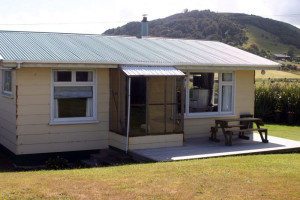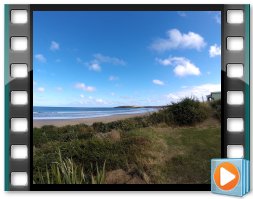The Nugget Point light house.
The shoreline below the light house was pretty cool. As Barb said above we saw seal basking in the sun on the rocks. It’s a tough life. 🙂
Our Curio Bay cottage from the road.
From the front lawn.
Speaking of a tough life. 🙂
This video shows the view of Curio Beach from our front lawn.
The next morning was fairly grey and cold and we had pants, long sleeved shirts and sweaters on (we spend many days here dressed like that). Our cottage owner operated a very small surfing school at the campground and I managed to convince a very reluctant Spencer to take a surfing lesson in the afternoon. Given the cold water, the cold and drizzly day, and our aging bodies, his reluctance was understandable. But I had never tried surfing and we could do it literally out our front door. So we signed ourselves up. Once the tide was up, the surfing dude drove onto the beach with his old jeep, with his trailer full of surf boards. There were three European 20 somethings joining us. The day before, the instructor had seen three Maori kids from Auckland struggling to surf on their dad’s old board, so he had lent them some boards and given them some instruction gratis, so they showed up again with big smiles on the faces, hoping to get another day on his boards. So he welcomed them in and started doling out boards. Spencer and I got the old people boards – about 10 inches of foam and VERY big. He was clearly a bit concerned about us but soldiered ahead.
Well, it was a blast. The sun came out, as did the Hector’s dolphins, who were surfing the waves with us. At one point, Spencer paddled further out and was within 3 feet of them, before he was waved back by the instructor. With the instructor’s help, I was able to get up and ride the “white water” (after the wave broke) in to shore twice and was quite happy with that. It was actually quite tiring, because even if you weren’t actually trying to ride the wave, walking out against the relentlessly bashing waves with a huge, floaty board was pretty wearing. And I managed to take a board in the nose and am still sporting a bruise on the nose. Spencer, on the other hand, was the star of the class, and got many good rides in. He actually got up on the “green water” (pre-break) and rode it in on his last ride. No one else managed to do that and the instructor could barely contain his glee. So that was really fun and we were both glad to have done it.
Sorry no pictures of the surfing. We were too busy surfing. 🙁
That night around 9:00 , we headed down toward the point where there is a rocky section on the coast that actually contains many fossilized tree stumps. We actually didn’t get much of a look at the stumps, as the area was roped off for yellow-eyed penguin viewing. There were about 20 people down there with cameras and binoculars, as well as a DOC person there to manage the “larger wildlife”, and we all waited patiently and quietly while about 8 penguins made it out of the water and over the long rocky section back to the bushes and their nests and chicks. One pair gave us a great show, as the rope was about 10 feet from where they entered the bushes to their nest. I think it took these two about 45 minutes of back and forth and head-tilting greetings before they both made it to the bush. One of their chicks was getting impatient for dinner so it waddled out of the bush enough for us to see, before being shoo-ed back in by a parent. It was a really good viewing, as these penguins are very rare and very shy, and will often go back into the water if they are scared off by people. The DOC is very concerned about this, as then the chicks don’t get fed, which is why they put an employee out there to make sure that people behave.
 The point just a short distance from the camp ground. The rock shelve gets exposed at low tide. The petrified tree stumps are out on this rock shelf. It is also where the yellow eyed penguins come ashore.
The point just a short distance from the camp ground. The rock shelve gets exposed at low tide. The petrified tree stumps are out on this rock shelf. It is also where the yellow eyed penguins come ashore.
This little one had crossed the rock shelf and was just about to enter the bush where its chicks were. We saw the chicks and I took some pictures but they didn’t come out. It was too dark and you can’t use a flash as it scares the penguins.
This pair kept passing one another on the rock and doing a little bonding dance. It was very cool.
The same pair passing on the rocks.
Trudging to the nest. This was our best yellow eyed penguin encounter.
The next morning we packed up again and headed to Invercargill, for the next leg of our journey.












Hot and cold water faucets are separate usually in England too. It had to do with the fact that cold water was stored in a tank in the attic to provide water pressure. Debris (things) could fall in the tank and die so somehow it was thought to be more hygienic to keep them separate. You fill up the bowl with whatever mix you want of hot and cold. Mostly you fill the kettle with cold water for tea 🙂